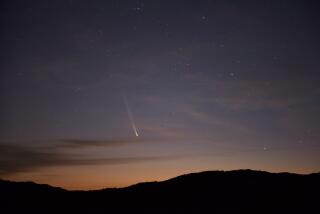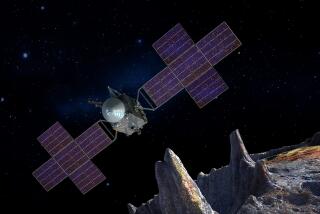JPL probe set for close encounter with comet
- Share via
Thursday morning at 7:01 a.m., a Jet Propulsion Laboratory probe will sweep within 434 miles of comet Hartley 2 and take its picture, only the fifth time a spacecraft will have captured images of a comet up close.
Each of those previous encounters has surprised scientists, painting a diverse picture of the makeup of comets, which were once thought to be little more than “dirty snowballs.” Hartley 2 has already startled researchers by spewing cyanide for eight days in early October.
Such events are usually violent and accompanied by massive amounts of dust, but this one was not, said astronomer Mike A’Hearn of the University of Maryland, principal investigator for the mission. “Hartley 2 has already put on a great show,” he said, “and we expect more of the unexpected during encounter.”
The spacecraft is Deep Impact, which launched an 820-pound copper impactor into the core of comet Tempel 1 on the Fourth of July in 2005, revealing that object to be less of a dirty snowball and more of a snowy dirtball made mostly of dust.
That impact was supposed to be the end of the $333-million mission, but NASA officials gave JPL controllers permission to aim the probe at another comet. The team settled on Hartley 2, discovered 24 years ago by British astronomer Malcolm Hartley working at the Schmidt Telescope in Australia. It orbits the sun every 6.46 years.
On Oct. 20, Hartley 2 passed within 11 million miles of Earth and was faintly visible to the naked eye. It made its closest approach to the sun last Thursday. It is still close by and can be seen with a telescope or binoculars. It will appear early in the morning on Wednesday and Thursday, passing in front of the feet of the constellation Gemini, to the right of Gemini’s brightest stars, Castor and Pollux.
The new mission, which cost about $30 million, was dubbed Deep Impact Extended Investigation, or DIXI. During its five-year voyage, the probe has trained its camera on distant stars, searching for exoplanets for a project called Extrasolar Planet Observation and Characterization, or EPOCh. Combining the two acronyms, the mission is now known as EPOXI.
The probe was designed to photograph Tempel 1 and simultaneously send those images back to Earth, but the orbital characteristics of Hartley 2 make that impossible this time around. Instead, for the last week, the craft has been alternately photographing the comet, then swinging its antenna back toward Earth to transmit the data. As it gets close, it will have to store all its data until the encounter is over before sending them back to waiting scientists.
Researchers hope the probe will transmit about five up-close pictures within the first hour, however, so they will begin to get an idea of the kind of information they have obtained.
There are many mysteries to be solved. Astronomers do not know why the comet spewed cyanide without releasing dust simultaneously. And Hartley 2 is emitting as much water vapor as Tempel 1, even though the latter has 10 times the surface area. A’Hearn hopes the new photos will provide fresh insight.
The encounter can be monitored live at https://www.ustream.tv/user/nasajpl2






